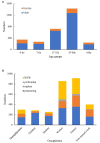Epidemiological and clinical characteristics of open globe injuries in Southwest China
- PMID: 38384411
- PMCID: PMC10879276
- DOI: 10.3389/fmed.2024.1303683
Epidemiological and clinical characteristics of open globe injuries in Southwest China
Abstract
Background: Open globe injuries (OGIs) are one of the leading causes of monocular vision loss, and the clinical characteristics of OGIs are region specific. The features and patterns of OGIs in Southwest China are poorly known and not well studied. Our study aimed to review the epidemiological and clinical characteristics of patients hospitalized for OGIs in Southwest China.
Methods: A retrospective study of OGI patients admitted to the West China Hospital from January 1st, 2015, to December 31st, 2019, was performed. Demographic characteristics and injury details were recorded. The Birmingham Eye Trauma Terminology system and the ocular trauma score (OTS) were used.
Results: A total of 3,014 patients were included. The male-to-female ratio was 5.2:1, and the mean age was 35.6 ± 19.1 years. 15.2% of patients were from the ethnic groups. The highest-risk occupation was the farmer (30.3%), followed by the worker (28.5%). OGIs occurred more frequently in people with middle (37.0%) and primary school (33.1%) education levels. Types of injuries included 46.8% penetration, 21.2% rupture, 2.9% perforation, and 29.1% intraocular foreign body (IOFB). The injuries types differed between age and occupation groups (p < 0.001). IOFBs had a higher risk of causing endophthalmitis, retinal detachment, and traumatic cataracts (p < 0.001). The most common injuries resulted from sharp objects (72.7%). The causes of the injuries were significantly associated with age, ethnicity, and occupation (p < 0.001). Explosion injuries and attacks by animals were more common among people of Tibetan and Yi ethnicities. Blunt trauma, vehicle crashes, falls and age older than 60 years were risk factors for a lack of light perception and lower OTS scores prognosis.
Conclusion: OGIs in Southwest China mainly affected working-aged males, especially workers or farmers. Severe vision loss and IOFBs are more common findings. OGIs in older patients and ethnic minorities requires additional attention.
Keywords: Southwest China; ethnic minorities; injuries types; intraocular foreign body; open globe injuries.
Copyright © 2024 Chen, Liang, Shi and Lu.
Conflict of interest statement
The authors declare that the research was conducted in the absence of any commercial or financial relationships that could be construed as a potential conflict of interest.
Figures



References
LinkOut - more resources
Full Text Sources

